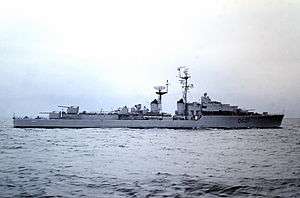French destroyer Surcouf (D621)
 Surcouf in 1970, a few months before her accident. The forward 57mm turret and the aft torpedo launchers had made way for an enlarged bridge and staff housing quarters when she was transformed into a flotilla leader ship. | |
| History | |
|---|---|
| Name: | Surcouf |
| Namesake: | Robert Surcouf |
| Laid down: | February 1951 |
| Launched: | October 1953 |
| Commissioned: | 1955 |
| Decommissioned: | 5 May 1972 |
| Homeport: | Brest and later Toulon |
| Fate: | Sunk as target |
| General characteristics | |
| Class and type: | T 47-class destroyer |
| Displacement: |
|
| Length: | 128.62 m (422.0 ft) |
| Beam: | 12.7 m (42 ft) |
| Draught: | 5.4 m (18 ft) |
| Installed power: | 63,000 shp (47,000 kW) |
| Propulsion: |
|
| Speed: | 34 kn (63 km/h) |
| Range: | 5,000 nmi (9,300 km) at 18 kn (33 km/h) |
| Complement: | 347 |
| Armament: |
|
Surcouf was a T 47-class destroyer of the French Navy. She was the fourth French ship named in honour of Robert Surcouf.
Design and construction
Laid down in February 1951 at Lorient and launched in October 1953, Surcouf was commissioned into the French Navy in 1955.[1] She was the first of 12 T 47-class destroyers.[2] With a standard displacement of 2,750 tons and a length of 128.6 metres, the ship had a beam of 12.7 metres and a draught of 5.4 metres. Her armament consisted of six 127-mm guns which were mounted in three twin turrets, six 57-mm guns in twin mounts and four single-mounted 20-mm guns. There were four banks of three 550-mm torpedo tubes, capable of launching both anti-submarine homing and anti-ship torpedoes. Surcouf had two shafts, geared turbines, and four boilers, which were capable of producing 63,000 horsepower and a top speed of 34 knots (71,725 shp (53,485 kW) and 38 knots during trials). At 18 knots, Surcouf had a range of 5,000 nautical miles. The ship had a complement of 347 personnel.[3]
Major modification
In the early 1960s, Surcouf was converted to a command ship to become a Flotilla Leader. In order to install an Operations centre and housings for an admiral and his staff, the forward 57mm mount was removed (extending forward the bridge) and the two aft torpedo platforms were removed so that housing quarters could be constructed.[3]
The overhaul was conducted the arsenal of Brest between 11 June 1960 (commencement of work) and 4 October 1961 (end of the tests).
Operational service
Following her commissioning in November 1955, Surcouf's homeport was Toulon, being assigned to the First destroyers flotilla (1st FEE), at the head of the Fourth destroyers Division (DEE4).
In 1956 she alternates naval exercises (including Nato's) and the Algerian coast surveillance. From October to December Surcouf took part in Operation Musketeer during the Suez Crisis.[4]
Early 1959 (on 10 April) her assignment and home Port are changed : Surcouf is attached to the Tenth destroyers Division (DEE10) into the light Fleet (the Escadre légère) based in Brest.
On 26 March 1960, Surcouf was accidentally rammed by the cargo ship Léognan off Groix, with big material damage but without making victim.
After her transformation into Flotilla Leader (June 1960-October 1961) Surcouf is assigned to the main Fleet (the Escadre), based in Toulon, where she sport the mark of the Admiral commanding the 1st FEE (ALFEE).
In March 1962, during the Battle of Bab El Oued, Surcouf was set to shell the OAS-held Bab el-Oued quarter of Algiers along with her sister ship Maillé-Brézé. After suggestions from the naval command, the bombardment was called off as impractical. The destroyers kept in station close to the shore as a deterrent.[1] Along with other three destroyers, both vessels had ferried troops to Algiers on 2 March to counter the OAS rebellion.[5]
Final fate
On 6 June 1971, before sunrise, in the Mediterranean 60 nautical miles (110 km) south east of Cartagena, Spain, as she sailed with the tactical group of the Arromanches, Surcouf was again rammed accidentally when she cut across the bow of the Soviet tanker General Busharov. The tanker, six times heavier than the destroyer, could not avoid the collision and rammed Surcouf at 16 knots. Nine men from Surcouf were lost at sea and one was severely burned (he later died of his wounds). When the French destroyer Tartu (which belonged to the same tactical group) attempted to tow the badly damaged ship, Surcouf snapped in two, the bow sinking quickly. The aft part was taken in tow to Toulon via Cartagena.
She was eventually sunk as a target by an Exocet anti-ship missile after being decommissioned on 5 May 1972.[1]
References
- Citations
- 1 2 3 Roche, Jean-Michel (2010). "Escorteur d'Escadre Surcouf" [Fleet Escort Surcouf] (in French). Netmarine.net. Retrieved 17 March 2012.
- ↑ "D 621 Surcouf DD". Harpoon Databases. Retrieved 21 May 2011.
- 1 2 Gardiner and Chumbley 1995. p. 110.
- ↑ "Operation Musketeer". Britain's Small Wars.com. Retrieved 21 May 2011.
- ↑ Labour research, Volumen 51, p. 112. Labour Research Department, 1962
- Bibliography
- Gardiner, Robert; Chumbley, Stephen (1995). Conway's All the World's Fighting Ships, 1947–1995. Annapolis, Maryland: Naval Institute Press. ISBN 978-1-55750-132-5.